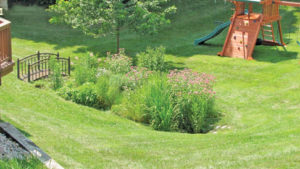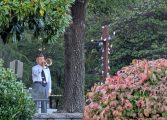By Page H. Gifford, Correspondent
 The Lake Monticello Wildlife Committee sponsored a program on rain gardens on May 6 with the goal to save wildlife habitats and prevent erosion.
The Lake Monticello Wildlife Committee sponsored a program on rain gardens on May 6 with the goal to save wildlife habitats and prevent erosion.
The speaker, Mary Eiserman, a biologist with the Thomas Jefferson Soil and Water Conservation District (TJSWCD), discussed ideas for rain gardens with those concerned with erosion and water runoff on their properties.
She explained that the TJSWCD has been around since 1935, and nowadays is concerned about storm water.
“We want to… improve water quality,” said Eiserman.
A rain garden is a natural solution compared to the retention ponds and pipes that have been used in the past. A depressed area with slopes, planted with native vegetation, collecting rainwater from hills, roads and roofs is the newest way of looking at a bioretention instead of ponds.
“A rain garden will reduce pollution in our lakes, rivers and streams and help recharge groundwater. It will keep rainwater on your property where it belongs, beautifying your landscape and creating native habitats for birds and butterflies and pollinators,” she said.
She discussed the best locations for a rain garden, which include areas with good infiltration, a minimum of 10 feet from a building and 50 feet from a septic field and with a maximum slope of 15 percent.
“Make sure it is sized to handle a run off from a one-inch storm.” She then talked about the calculations needed to determine this with formulas for both impervious and pervious surfaces. Eiserman gave a complex explanation of the coefficients needed to make the calculations which she and others at TJSWCD would use to help anyone interested in creating a rain garden.
“Limiting clay is very important,” she added. She showed a diagram of how the garden is built from the ground up and then maintained with yearly mulching, weeding, and raking. Key for the wildlife committee were the habitats that could be created for birds and butterflies and other pollinating insects, including berries for birds, flowers for pollinators and milkweed for butterflies.
She suggested using native plants and vegetation that are also deer resistant. Grasses and ferns are good choices, as well as Lobelia, Wild Ginger, False Indigo and Joe Pye weed – named after and Indian healer who used it for fevers.
Eiserman ended by talking about the ways in which the TJSWCD can help property owners with creating their own rain garden and in some cases defraying costs. Property owners can find out more about the Virginia Conservation Assistance Program.
“The average cost of a small to medium rain garden ranges from $800 to $3,500,” said Eiserman. One audience member asked if filling in a slope with gravel or other rock would be a good idea. Eiserman suggested building a berm with grasses. If it is a concentrated flow, then large rock could be used but gravel would wash away. Others asked what to do with the multitudes of leaves at Lake Monticello.
“Leave them where they are, they are a natural ground cover,” she said.
Jack Day, co-chair of the LM Wildlife Committee, stated he always heard oak leaves were good for the soil. Eiserman agreed and another audience member said she mulches her leaves and puts them around as ground cover. Others who lived on the Lake had concerns about the leaves getting into the lake. Eiserman said it creates sediment buildup.
For more information, contact Mary Eiserman at mary.eiserman@tjswcd.org. Other information is available at http://dof.virginia.gov/infopubs/Rain-Garden-Technical-Guide-2014-05_pub.pdf.




